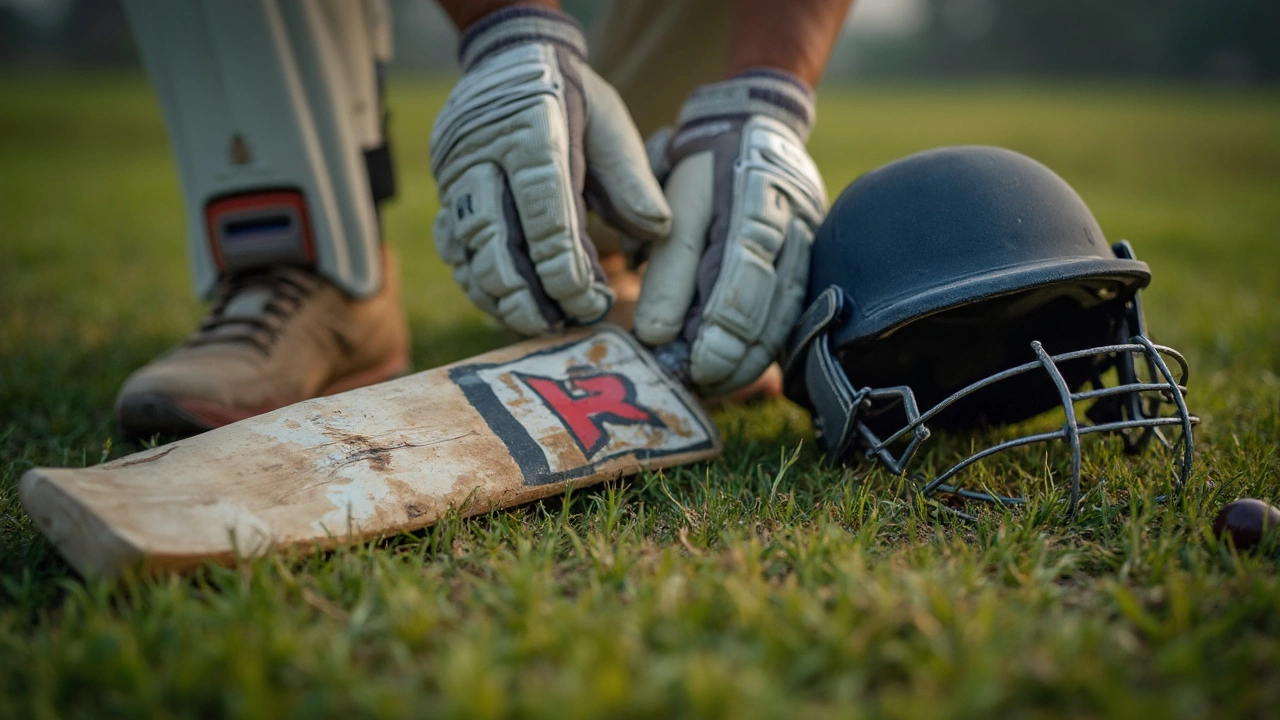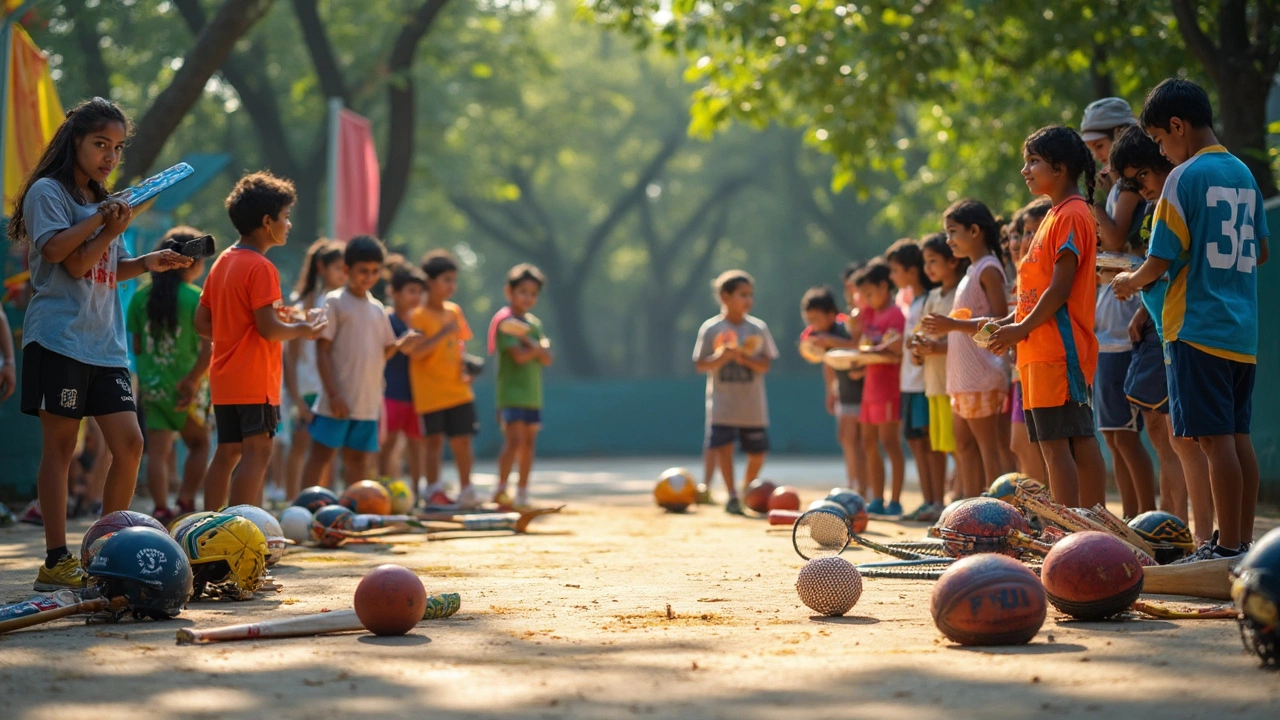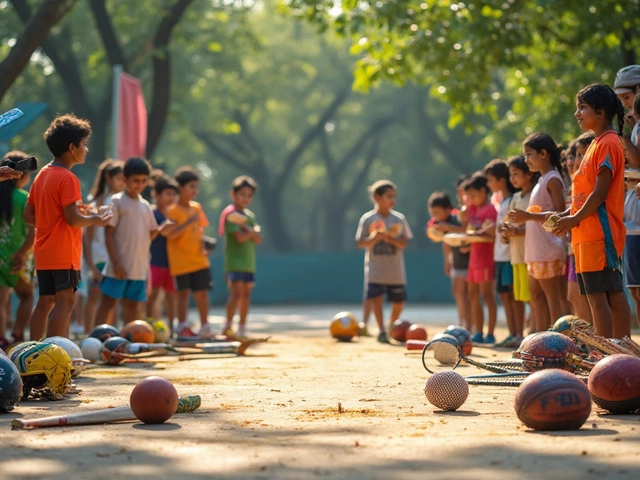Ever notice how even backyard soccer turns into chaos without a proper ball? Sport equipment isn’t just for show. It’s the backbone of how we play, train, and stay safe, whether you’re hitting a baseball or going for a swim. Some gear, like helmets and pads, is there mostly to protect—no one likes a chipped tooth from a wild hockey puck. Other stuff, like special shoes or rackets, is built to help you move better, score more, or just enjoy the game without the struggle.
If you’ve tried running in everyday sneakers, you probably felt the difference. That’s because the right equipment is designed for a specific job. It can cut your risk of injury and help you get more from your practice. Even Max, my dog, has his own ‘sports gear’ for fetch—trust me, a sturdy ball stops those embarrassing mid-game breaks. Good gear makes results and experiences better, whether you’re a rookie or eyeing a spot in the big leagues.
- Why We Use Sport Equipment
- Safety First: Gear That Protects
- Boosting Performance
- Training Smarter, Not Harder
- Sport Equipment for Every Level
- Tips for Choosing the Right Gear
Why We Use Sport Equipment
People use sport equipment for a few big reasons that go way beyond just playing by the rules. The main ones are improving performance, preventing injuries, making the game fair, and sometimes, just having more fun. For example, using the right basketball or racket isn’t just a suggestion—without it, you simply can’t play the actual sport the way it’s meant to be played. Equipment also helps match up players of different skill levels, so a newbie and a pro both get a shot to enjoy the game.
Look at cycling. Racing bikes can weigh half as much as regular bikes but help shave minutes off your time. In baseball, using a bat that matches your size and strength can actually cut down on arm injuries by a huge margin. Some sports just can’t happen at all without the right gear. Try playing golf without clubs or hockey without sticks—the game stops before it starts.
It’s not just about performance, though. Safety is a huge deal. The American Orthopaedic Society for Sports Medicine points out that nearly 2 million injuries happen to kids in sports each year, and using the right gear can stop a lot of them. Good equipment lets more people participate safely, from kids to seniors. Without helmets, knee pads, or guards, more folks would skip sports entirely.
"The right equipment lets athletes focus on technique and skill, instead of worrying about safety." – Dr. Angela Smith, American College of Sports Medicine
There’s also the issue of fairness. Standardizing things like the size of a basketball or the weight of a discus keeps competition level for everyone. Referees and coaches check equipment before games because tiny tweaks—a too-heavy bat or too-flat ball—can totally change the outcome.
Here’s a quick peek at how sport equipment shapes experience in different sports:
| Sport | Must-have Equipment | Purpose |
|---|---|---|
| Football | Helmet, pads, cleats | Protection, traction |
| Swimming | Goggles, swim cap | Vision, speed |
| Tennis | Racket, shoes | Power, grip |
| Cycling | Bike, helmet | Performance, safety |
| Hockey | Stick, skates, pads | Control, protection |
So whether you’re playing outside with friends or going pro, the right gear shapes how the game is played, keeps players safe, and makes sure everyone gets a fair shot. Next time you pick up a ball or helmet, you’re not just following the rules—you’re setting yourself up for a better, safer experience.
Safety First: Gear That Protects
Let’s be real: nobody enjoys sitting out a game because of an injury that good equipment could’ve prevented. The main reason we use sport equipment is to keep from getting hurt. Some gear is an absolute must, especially for high-contact sports or ones where hard objects move at stupid speeds (think hockey, football, or even baseball).
Take helmets, for example. A helmet in football gives your head a fighting chance against concussions. In cycling, a helmet cuts your chance of serious head injury by roughly 50%. Mouthguards are another unsung hero, protecting teeth and jaws when the action gets rough. And in sports like cricket or baseball, pads and gloves can mean the difference between a bruise and a broken finger.
Here’s a quick look at just how much protective equipment can help:
| Sport | Main Safety Gear | Injury Reduction (%) |
|---|---|---|
| Cycling | Helmet | 50 |
| Football | Helmet, shoulder pads | 30 |
| Hockey | Helmet, face cage | 40 |
| Boxing | Mouthguard | 60 |
| Baseball | Batting helmet, chest guard | 35 |
It’s not just body parts getting protection—think of how shin guards in soccer save you from painful studs, or how good gloves stop baseball fingers from turning purple. Even swimmers use specific gear to avoid ear infections or eye problems from chlorine.
- Always check that your equipment fits right. Gear that’s too loose doesn’t guard you well.
- Replace items like helmets after any hard hit or once they’re past their lifetime.
- If you’re not sure what you need for a new sport, ask a coach or someone who plays regularly. Better to be safe and look like a rookie than end up injured.
Skipping proper gear to save time or cash just isn’t worth the risk. A bit of planning now means you’ll stay in the game longer, with fewer surprises in the doctor’s office.
Boosting Performance
The right sport equipment can be a total game changer. It’s not hype—good gear literally helps you run faster, jump higher, and control the ball or puck better. Let’s break it down. Lighter tennis rackets help you swing faster, which means more power and spin. Running shoes with foam cushioning can help shave seconds off your mile time. Even something simple like wearing compression socks has been shown to boost circulation so your legs don’t burn out as fast on long runs.
Take a look at what pros use and you’ll notice they never pick “just any” gear. Soccer cleats with molded studs let you grip the field and cut quickly, while basketball shoes with impact-absorbing soles protect your knees when landing those jumps. There’s a real difference in the numbers—check out the table below for some examples:
| Equipment | Performance Upgrade | Research/Stat |
|---|---|---|
| Carbon Fiber Bike | Faster acceleration, easier climbs | Up to 15% lighter than standard bikes |
| Graphite Tennis Racket | Higher swing speed, improved control | Up to 20% faster ball exit speed |
| Performance Running Shoes | Energy return, less fatigue | Can improve running economy by 4% |
A small tweak in your gear can even help you overcome sticking points in your training. Some swimmers see a drop of half a second per lap just by switching to a sleeker swimsuit designed to reduce drag. And don’t forget training aids, like weighted vests for runners or resistance bands for sprinters—they’re all about building muscle faster and smashing your previous bests.
- Try on equipment before buying; don’t just order what looks cool online.
- Look for gear tested by serious players or reviewed by coaches.
- Keep your equipment in good shape—worn-out shoes or warped bats mean you lose performance and might get hurt.
If you’re serious about improvement, pay attention to your sport equipment. Sometimes, a small investment pays back with way better results and a lot more fun on the field.

Training Smarter, Not Harder
The truth is, grinding through workouts won’t help much unless you’ve got the right sport equipment by your side. It's not just about sweating more—it’s about making every move count. With the right gear, you get feedback that helps you improve, spot mistakes, and avoid doing the same thing wrong a hundred times.
Take heart rate monitors. They aren’t only for serious athletes anymore. A decent watch will keep your effort in check, which means you’re less likely to overtrain or burn out. Resistance bands? They let you work on strength and mobility at home, in the park, or anywhere with enough space to stretch.
These days, there’s smart gear for almost everything. Basketball players use weighted balls to boost their passing power. Runners strap on GPS watches to track distance and pace down to the meter. Even basic agility ladders are popping up in soccer practices to sharpen footwork. All this stuff means you target your weak spots instead of wasting time on things you’ve already nailed.
Here’s a taste of how certain equipment helps with specific goals:
- Sport equipment: Whether using cones for drills or foam rollers for recovery, gear is like having a coach in your pocket.
- Wearables: Devices that count steps, measure sprints, or analyze your swing help you see progress in real time.
- Recovery tools: Foam rollers, massage guns, and ice packs cut down recovery time so you bounce back faster for the next round.
Just because you’re not training for the Olympics doesn’t mean this stuff can’t help. Research from 2023 even showed that athletes using GPS watches improved their pacing consistency by 15% compared to those just guessing their speed. Here’s a quick look at how some common tools stack up for effectiveness:
| Equipment | Main Benefit | Average Improvement |
|---|---|---|
| Heart Rate Monitor | Avoids overtraining | 12% better recovery time |
| Weighted Basketball | Boosts passing power | 17% stronger passes |
| GPS Running Watch | Consistent pacing | 15% better pacing |
| Foam Roller | Speeds up muscle recovery | 30% less soreness |
If you’re on a tight budget, pick one or two basics like a jump rope or a set of resistance bands. Trust me, even pro athletes go back to these when they want to nail form or push for that extra edge. It’s not about buying the fanciest thing out there—it’s about getting tools that help you actually get better, not just tired.
Sport Equipment for Every Level
Not all sport equipment is made the same, and it shouldn’t be. Beginners need gear that helps them learn, while experienced athletes need tools to push their limits. Let’s break it down—whether you’re just getting started or you already know your way around a court, there’s a reason behind every piece of equipment you use.
For newcomers, basic gear keeps things simple and safe. Think easy-grip tennis rackets, lighter basketballs for smaller hands, and adjustable soccer goals for a backyard kickabout. When folks first start out, the right equipment builds skills and confidence without overwhelming them.
As you level up, your needs change. Advanced gear comes with more features—like baseball bats made of stronger materials, shoes designed for serious grip, or high-tech swim goggles that cut down on water drag. Imagine a study from 2023 found that high school athletes using sport-specific equipment reported 30% fewer overuse injuries than those using generic or hand-me-down gear. That’s a pretty solid reason to upgrade as your skills grow.
Equipment also gets more specialized at the elite level. Professional runners, for example, use shoes that are custom-fitted right down to the way their toes bend. Some sports even have rules about what you can and can’t use, so things stay fair. Check out this quick look at how gear differs by level:
| Level | Common Gear Features | Purpose |
|---|---|---|
| Beginner | Lightweight, basic, adjustable | Easy learning, safety, comfort |
| Intermediate | Durable, standard size, better fit | Skill development, confidence, more challenge |
| Advanced/Pro | Specialized, custom-fit, high-performance materials | Maximize results, meet professional standards |
One more thing: don’t let fancy gear fool you. It’s not about having the priciest stuff in the shop—it’s about using sport equipment that matches your current skills and goals. That’s what helps you get better, safer, and actually enjoy what you’re doing.
Tips for Choosing the Right Gear
It’s easy to feel lost walking into a giant sports store or scrolling endless gear pages online. But choosing sport equipment isn’t just grabbing whatever looks cool or has the biggest discount. Your performance and safety sometimes depend entirely on gear that fits you, your sport, and your goals.
Step one, check sizing charts and try stuff on whenever you can. A tennis racket that’s too heavy or a helmet that shifts when you shake your head will slow you down and might even set you up for injuries. Shoe companies like Nike and Adidas often release sizing tables with a 1-2 cm variation between models—don’t just guess your size because you wore it last year.
Materials matter too. For example, soccer balls used in professional matches are made with at least four layers and thermally bonded panels, which makes them last longer and keep shape even after hundreds of kicks. Meanwhile, gym brands like Rogue or Bowflex show in tests that higher-quality steel in weights and benches reduces failures by up to 30% over cheaper models.
- Check for certificates—Labels like ASTM or CE mean the equipment meets safety standards. Don’t buy helmets or pads that lack these.
- Opt for versatility if you’re starting out—Adjustable dumbbells, adjustable jump ropes, or shoes designed for cross-training let you experiment before specializing.
- Weight matters—The average baseball bat used by pros weighs between 32-34 ounces. Lighter for kids, but heavier bats are for stronger, experienced players. Right weight makes a big difference in results and comfort.
- Comfy and washable—If you’re sweating buckets in hot weather, materials with moisture-wicking properties (like Dri-FIT or ClimaLite) make life much easier.
- Read user reviews—Look out for comments about unexpected wear, straps that break, or sizing running small or large. Actual experience often beats the marketing text.
Here’s a quick look at how spending and satisfaction line up for common gear:
| Equipment | Avg. Cost (USD) | Avg. Lifespan (Years) | User Satisfaction (%) |
|---|---|---|---|
| Running Shoes | 120 | 1 | 78 |
| Basketball | 45 | 2 | 85 |
| Soccer Ball | 60 | 1.5 | 83 |
| Basic Helmet | 80 | 3 | 88 |
| Adjustable Dumbbells | 250 | 6 | 91 |
Take your time before buying. If you’re investing in gear for your kids, look for used options—you’ll find stuff in almost-new condition, since kids outgrow things fast. For any sport, picking the right equipment from the start keeps you safer, helps you enjoy the game, and saves you money in the long run.



